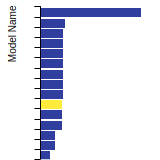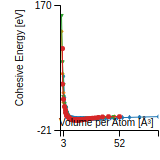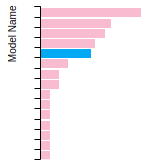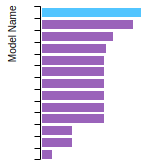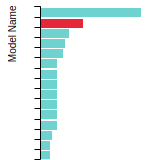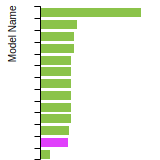 EAM_Dynamo_HanZepedaAckland_2003_V__MO_411020944797_000
EAM_Dynamo_HanZepedaAckland_2003_V__MO_411020944797_000
| Title
A single sentence description.
|
Finnis-Sinclair potential (LAMMPS cubic hermite tabulation) for V developed by Han et al. (2003) v000 |
|---|---|
| Description
A short description of the Model describing its key features including for example: type of model (pair potential, 3-body potential, EAM, etc.), modeled species (Ac, Ag, ..., Zr), intended purpose, origin, and so on.
|
Finnis-Sinclair potential for V developed by Han et al. (2003) in EAM form. In order to provide the input information required to fit a vanadium potential appropriate for radiation damage studies, we perform a series of first-principles calculations on six different interstitial geometries and vacancies. These calculations identify the 〈111〉dumbbell as the most stable interstitial with a formation energy of approximately 3.1 eV, at variance with predictions based upon existing potentials. Our potential is of Finnis–Sinclair type and is fitted exactly to the experimental equilibrium lattice parameter, cohesive energy, elastic constants and a calculated unrelaxed vacancy formation energy. Two additional potential parameters were used to obtain the best fit to the set of interstitial formation energies determined from the first-principles calculations. The resulting potential was found to accurately predict both the magnitude and ordering of the formation energies of six interstitial configurations and the unrelaxed vacancy ground state, in addition to accurately describing the migration characteristics of the stable interstitial and vacancy. This vanadium potential is capable of describing the point defect properties appropriate for radiation damage simulations as well as for simulations of more common crystal and simple defect properties. |
| Species
The supported atomic species.
| V |
| Disclaimer
A statement of applicability provided by the contributor, informing users of the intended use of this KIM Item.
|
None |
| Content Origin | NIST IPRP (https://www.ctcms.nist.gov/potentials/V.html) |
| Content Other Locations | http://homepages.ed.ac.uk/graeme/moldy/moldy.html |
| Contributor |
Ellad B. Tadmor |
| Maintainer |
Ellad B. Tadmor |
| Developer |
Seungwu Han Graeme J. Ackland David J. Srolovitz Luis A. Zepeda-Ruiz Roberto Car |
| Published on KIM | 2018 |
| How to Cite | Click here to download this citation in BibTeX format. |
| Citations
This panel presents information regarding the papers that have cited the interatomic potential (IP) whose page you are on. The OpenKIM machine learning based Deep Citation framework is used to determine whether the citing article actually used the IP in computations (denoted by "USED") or only provides it as a background citation (denoted by "NOT USED"). For more details on Deep Citation and how to work with this panel, click the documentation link at the top of the panel. The word cloud to the right is generated from the abstracts of IP principle source(s) (given below in "How to Cite") and the citing articles that were determined to have used the IP in order to provide users with a quick sense of the types of physical phenomena to which this IP is applied. The bar chart shows the number of articles that cited the IP per year. Each bar is divided into green (articles that USED the IP) and blue (articles that did NOT USE the IP). Users are encouraged to correct Deep Citation errors in determination by clicking the speech icon next to a citing article and providing updated information. This will be integrated into the next Deep Citation learning cycle, which occurs on a regular basis. OpenKIM acknowledges the support of the Allen Institute for AI through the Semantic Scholar project for providing citation information and full text of articles when available, which are used to train the Deep Citation ML algorithm. |
This panel provides information on past usage of this interatomic potential (IP) powered by the OpenKIM Deep Citation framework. The word cloud indicates typical applications of the potential. The bar chart shows citations per year of this IP (bars are divided into articles that used the IP (green) and those that did not (blue)). The complete list of articles that cited this IP is provided below along with the Deep Citation determination on usage. See the Deep Citation documentation for more information. 
67 Citations (48 used)
Help us to determine which of the papers that cite this potential actually used it to perform calculations. If you know, click the .
USED (definite) J. J. Moller et al., “110
planar faults in strained bcc metals: Origins and implications of a commonly observed artifact of classical potentials,” Physical Review Materials. 2018. link Times cited: 18 Abstract: Large-scale atomistic simulations with classical potentials … read more USED (high confidence) K. M. Davoudi, “Displacement field due to glide and climb of rectilinear dislocations in gradient elasticity,” Philosophical Magazine. 2020. link Times cited: 0 Abstract: ABSTRACT The aim of this article is to provide the displacem… read more USED (high confidence) J. Byggmastar, K. Nordlund, and F. Djurabekova, “Gaussian approximation potentials for body-centered-cubic transition metals,” Physical Review Materials. 2020. link Times cited: 22 Abstract: We develop a set of machine-learning interatomic potentials … read more USED (high confidence) G. Lerma, B. Verschueren, B. Gurrutxaga-Lerma, and J. Verschueren, “Generalized Kanzaki force field of extended defects in crystals with applications to the modeling of edge dislocations,” Physical Review Materials. 2019. link Times cited: 4 Abstract: The Kanzaki forces and their associated multipolar moments a… read more USED (high confidence) S. Xu and Y. Su, “Dislocation nucleation from symmetric tilt grain boundaries in body-centered cubic vanadium,” Physics Letters A. 2018. link Times cited: 24 USED (high confidence) A. Arjhangmehr and S. Feghhi, “Evolution pattern of collision cascades in bcc V with different grain boundary structures: an atomic scale study,” Philosophical Magazine. 2017. link Times cited: 6 Abstract: In this paper, by means of atomic-scale simulations, we inve… read more USED (high confidence) X.-T. Shu, S. Xiao, H. Deng, L. Ma, and W. Hu, “Atomistic simulation of crack propagation in single crystal tungsten under cyclic loading,” Journal of Materials Research. 2017. link Times cited: 12 Abstract: The propagation of a pre-existing center crack in single cry… read more USED (high confidence) X. Zhu, C. Wang, N. Hu, W. Hu, W. Duan, and L. Yang, “Irradiation damage of helium-accumulated vanadium: atomic simulations,” RSC Advances. 2016. link Times cited: 2 Abstract: Molecular dynamics simulations have been implemented to gain… read more USED (high confidence) Z. Chen, G. Lu, N. Kioussis, and N. Ghoniem, “The crucial role of chemistry on mobile properties of dislocation,” Philosophical Magazine. 2010. link Times cited: 0 Abstract: Dislocation–solute interactions are ubiquitous in solids, ye… read more USED (high confidence) Z. Chen, G. Lu, N. Kioussis, and N. Ghoniem, “Effect of the local environment on the mobility of dislocations in refractory bcc metals: Concurrent multiscale approach,” Physical Review B. 2008. link Times cited: 5 Abstract: Using a concurrent multiscale approach we demonstrate that t… read more USED (high confidence) M. Mendelev, S. Han, W. Son, G. Ackland, and D. Srolovitz, “Simulation of the interaction between Fe impurities and point defects in V,” Physical Review B. 2007. link Times cited: 56 Abstract: We report improved results of atomistic modeling of V-Fe all… read more USED (high confidence) L. Zepeda-Ruiz, J. Rottler, B. Wirth, R. Car, and D. Srolovitz, “Self-interstitial transport in vanadium,” Acta Materialia. 2005. link Times cited: 22 USED (high confidence) L. Zepeda-Ruiz, J. Marian, and B. D. W. *, “On the character of self-interstitial dislocation loops in vanadium,” Philosophical Magazine. 2005. link Times cited: 5 Abstract: Molecular statics and molecular dynamics simulations based o… read more USED (high confidence) L. Zepeda-Ruiz, S. Han, D. Srolovitz, R. Car, and B. Wirth, “Molecular dynamics study of the threshold displacement energy in vanadium,” Physical Review B. 2003. link Times cited: 27 Abstract: The threshold displacement energy (TDE) is calculated for va… read more USED (low confidence) Z. Yan, J. Zhao, R. Liu, B. Liu, Y.-lin Shao, and M. Liu, “An insight into sintering mechanisms of silicon carbide nanoparticles with additives using MD simulation,” Powder Technology. 2023. link Times cited: 0 USED (low confidence) R. Qiu et al., “Molecular dynamics simulations of displacement cascades in vanadium: Generation and types of dislocation loops,” Nuclear Materials and Energy. 2023. link Times cited: 1 USED (low confidence) R. Wang et al., “Classical and machine learning interatomic potentials for BCC vanadium,” Physical Review Materials. 2022. link Times cited: 3 Abstract: BCC transition metals (TMs) exhibit complex temperature and … read more USED (low confidence) R. Zheng, L. Yang, and L. Zhang, “Grain Boundary Migration as a Self-Healing Mechanism of Tungsten at High Temperature,” Metals. 2022. link Times cited: 2 Abstract: The tungsten components in nuclear fusion reactors need to w… read more USED (low confidence) X. Huang et al., “Effect of Re aggregation doping configurations on the thermal and mechanical properties of W-Re alloys:A molecular dynamics study,” Journal of Nuclear Materials. 2022. link Times cited: 2 USED (low confidence) I. Shepelev, D. Bachurin, E. Korznikova, and S. Dmitriev, “Highly efficient energy and mass transfer in bcc metals by supersonic 2-crowdions,” Journal of Nuclear Materials. 2022. link Times cited: 7 USED (low confidence) P. Hiremath, S. Melin, E. Bitzek, and P. Olsson, “Effects of interatomic potential on fracture behaviour in single- and bicrystalline tungsten,” Computational Materials Science. 2022. link Times cited: 14 USED (low confidence) H. Wang, Z. Dong, S. Yuan, X. Guo, R. Kang, and Y. Bao, “Effects of tool geometry on tungsten removal behavior during nano-cutting,” International Journal of Mechanical Sciences. 2022. link Times cited: 19 USED (low confidence) R. Murzaev, A. Y. Morkina, and I. I. Tuvalev, “Dynamics of delocalized vibrational modes in bcc W: impact of interatomic potential,” Saratov Fall Meeting. 2022. link Times cited: 0 Abstract: In the bcc W, the simulation of oscillations was carried out… read more USED (low confidence) U. Gökmen, Z. Özkan, U. Taşci, and Ocak S. Bi̇lge, “Investigation of radiation shielding by adding Al2O3 and SiO2 into the high-speed steel composites: comparative study,” Physica Scripta. 2022. link Times cited: 6 Abstract: In this study, Phy-X/PSD software was utilized for searching… read more USED (low confidence) N. Gayathri et al., “Post irradiated microstructure and mechanical properties of pure V,” Journal of Nuclear Materials. 2022. link Times cited: 4 USED (low confidence) Z. Zhang, S.-L. Lu, J.-B. Yang, and Z.-F. Zhang, “The criterion of anomalous slip at 0 K in body centered cubic metals,” Tungsten. 2022. link Times cited: 0 USED (low confidence) Y. Sun, X. Huang, F. Liu, and H. Chu, “Equivalent surface energy of nanovoids in metallic crystals,” Computational Materials Science. 2021. link Times cited: 3 USED (low confidence) N. Bertin, W. Cai, S. Aubry, and V. Bulatov, “Core energies of dislocations in bcc metals,” Physical Review Materials. 2021. link Times cited: 5 Abstract: Accurate methods and an efficient workflow for computing and… read more USED (low confidence) P. Weck, P. Kalita, T. Ao, S. Crockett, S. Root, and K. Cochrane, “Shock compression of vanadium at extremes: Theory and experiment,” Physical Review B. 2020. link Times cited: 7 USED (low confidence) X. Guo et al., “Study on subsurface layer of nano-cutting single crystal tungsten in different crystal orientations,” Applied Surface Science. 2020. link Times cited: 18 USED (low confidence) X.-T. Li, X. Tang, Y. Fan, and Y. Guo, “The interstitial emission mechanism in a vanadium-based alloy,” Journal of Nuclear Materials. 2020. link Times cited: 9 USED (low confidence) Y. Chen, X. Liao, N. Gao, W. Hu, F. Gao, and H. Deng, “Interatomic potentials of W–V and W–Mo binary systems for point defects studies,” Journal of Nuclear Materials. 2020. link Times cited: 13 USED (low confidence) Z. Xia, Z. Zhang, J.-X. Yan, J. Yang, and Z. F. Zhang, “Simulation of the interaction between two different 1/2<111> screw dislocations in body-centered-cubic metal niobium,” Computational Materials Science. 2020. link Times cited: 5 USED (low confidence) D. Wen, Y. Deng, X. Dai, Z.-an Tian, Y. Mo, and P. Peng, “Evolution of local atomic structures during rapid solidification of liquid metal W,” Modern Physics Letters B. 2018. link Times cited: 3 Abstract: Molecular dynamics (MD) simulations were performed to invest… read more USED (low confidence) M. Poschmann, J. Lin, H. Geerlings, I. Winter, and D. Chrzan, “Strain-induced variant selection in heterogeneous nucleation of
α
-Ti at screw dislocations in
β
-Ti,” Physical Review Materials. 2018. link Times cited: 4 Abstract: Heterogeneous nucleation of the α to β phase transition at 〈… read more USED (low confidence) M. Jin, C. Permann, and M. Short, “Breaking the power law: Multiscale simulations of self-ion irradiated tungsten,” Journal of Nuclear Materials. 2018. link Times cited: 9 USED (low confidence) J. Fu, X. Li, B. Johansson, and J. Zhao, “Improved Finnis-Sinclair potential for vanadium-rich V–Ti–Cr ternary alloys,” Journal of Alloys and Compounds. 2017. link Times cited: 13 USED (low confidence) G. Ackland, “Rapid Equilibration by algorithmic quenching the ringing mode in molecular dynamics,” MRS Advances. 2016. link Times cited: 5 Abstract: Long wavelength acoustic phonons are normally weakly coupled… read more USED (low confidence) W. Zhang et al., “Development of a pair potential for Ni–He,” Journal of Nuclear Materials. 2016. link Times cited: 10 USED (low confidence) S. Xu, Z. Hao, Y. Su, W. J. Hu, Y. Yu, and Q. Wan, “Atomic collision cascades on void evolution in vanadium,” Radiation Effects and Defects in Solids. 2012. link Times cited: 12 Abstract: Molecular dynamics simulations were performed to study void … read more USED (low confidence) T. Klaver, D. Hepburn, and G. Ackland, “Defect and solute properties in dilute Fe-Cr-Ni austenitic alloys from first principles,” Performance Evaluation. 2011. link Times cited: 54 Abstract: We present results of an extensive set of first-principles d… read more USED (low confidence) G. Liu, G. Liu, D. Nguyen-Manh, B. Liu, and D. Pettifor, “Magnetic properties of point defects in iron within the tight-binding-bond Stoner model,” Physical Review B. 2005. link Times cited: 48 Abstract: The tight-binding Stoner model of band magnetism is generali… read more USED (low confidence) S. Dudarev, “’quantum core’ interatomic potentials for transition metals,” Journal of Nuclear Materials. 2004. link Times cited: 4 USED (low confidence) Z. Yan, H. Sheng, E. Ma, B. Xu, J. Li, and L. Kong, “Intermediate structural evolution preceding growing BCC crystal interface in deeply undercooled monatomic metallic liquids,” Acta Materialia. 2021. link Times cited: 6 USED (low confidence) Y.-qi Jiang, “Study the atomistic structure of monatomic vanadium under different cooling rates by molecular dynamics simulation,” Journal of Molecular Liquids. 2021. link Times cited: 5 USED (low confidence) G. Ackland and G. Bonny, “Interatomic Potential Development,” Comprehensive Nuclear Materials. 2020. link Times cited: 4 USED (low confidence) Y. Ashkenazy and R. Averback, “Kinetic stages in the crystallization of deeply undercooled body-centered-cubic and face-centered-cubic metals,” Acta Materialia. 2010. link Times cited: 68 USED (low confidence) K. Nordlund and R. Averback, “Point Defects in Metals.” 2005. link Times cited: 2 NOT USED (low confidence) I. V. Kosarev, S. A. Shcherbinin, A. Kistanov, R. Babicheva, E. Korznikova, and S. V. Dmitriev, “An approach to evaluate the accuracy of interatomic potentials as applied to tungsten,” Computational Materials Science. 2024. link Times cited: 1 NOT USED (low confidence) A. Lipnitskii and V. Saveliev, “Development of n-body expansion interatomic potentials and its application for V,” Computational Materials Science. 2016. link Times cited: 20 NOT USED (low confidence) S. Zinkle, “Overview of the U.S. Fusion Materials Sciences Program,” Fusion Science and Technology. 2004. link Times cited: 15 Abstract: Highlights of recent U.S. fusion materials research activiti… read more NOT USED (low confidence) R. Kurtz et al., “Recent progress on development of vanadium alloys for fusion,” Journal of Nuclear Materials. 2004. link Times cited: 135 NOT USED (high confidence) Q. Yang and P. Olsson, “Full energy range primary radiation damage model,” Physical Review Materials. 2021. link Times cited: 9 Abstract: A full energy range primary radiation damage model is presen… read more NOT USED (high confidence) K. Kowalczyk-Gajewska and M. Ma’zdziarz, “Elastic properties of nanocrystalline materials of hexagonal symmetry: The core-shell model and atomistic estimates,” International Journal of Engineering Science. 2020. link Times cited: 5 NOT USED (high confidence) A. Kartamyshev et al., “Angular dependent interatomic potential for Ti–V system for molecular dynamics simulations,” Modelling and Simulation in Materials Science and Engineering. 2020. link Times cited: 7 Abstract: An interatomic potential for the Ti–V binary alloy focusing … read more NOT USED (high confidence) K. Kowalczyk-Gajewska and M. Maździarz, “Effective stiffness tensor of nanocrystalline materials of cubic symmetry: The core-shell model and atomistic estimates,” International Journal of Engineering Science. 2019. link Times cited: 5 NOT USED (high confidence) L. Lang et al., “Development of a Ni–Mo interatomic potential for irradiation simulation,” Modelling and Simulation in Materials Science and Engineering. 2019. link Times cited: 5 Abstract: An interatomic potential for the Ni–Mo binary alloy focusing… read more NOT USED (high confidence) A. Takahashi, A. Seko, and I. Tanaka, “Linearized machine-learning interatomic potentials for non-magnetic elemental metals: Limitation of pairwise descriptors and trend of predictive power.,” The Journal of chemical physics. 2017. link Times cited: 20 Abstract: Machine-learning interatomic potential (MLIP) has been of gr… read more NOT USED (high confidence) A. T. Raji, S. Scandolo, R. Mazzarello, S. Nsengiyumva, M. Härting, and D. T. Britton, “Ab initio pseudopotential study of vacancies and self-interstitials in hcp titanium,” Philosophical Magazine. 2009. link Times cited: 48 Abstract: By means of an ab initio plane-wave pseudopotential method, … read more NOT USED (high confidence) Y. Abe and H. Matsui, “Effects of undersized Fe atoms on the stability of interstitials near a dislocation core in V studied by molecular dynamics simulation,” Journal of Computer-Aided Materials Design. 2007. link Times cited: 2 NOT USED (high confidence) A. Semenov and C. Woo, “Void lattice formation as a nonequilibrium phase transition,” Physical Review B. 2006. link Times cited: 26 Abstract: The evolution of a void ensemble in the presence of one-dime… read more NOT USED (high confidence) S. Dudarev, “Angular-dependent matrix potentials for fast molecular-dynamics simulations of transition metals,” Journal of Physics: Condensed Matter. 2006. link Times cited: 5 Abstract: The significance of the part played by the angular-dependent… read more NOT USED (high confidence) S. Zinkle, “Fusion materials science: Overview of challenges and recent progressa),” Physics of Plasmas. 2005. link Times cited: 248 Abstract: A brief review is given of fundamental materials science con… read more NOT USED (high confidence) G. Ackland, M. Mendelev, D. Srolovitz, S. Han, and A. Barashev, “Development of an interatomic potential for phosphorus impurities in α-iron,” Journal of Physics: Condensed Matter. 2004. link Times cited: 542 Abstract: We present the derivation of an interatomic potential for th… read more NOT USED (high confidence) W. Hu, H. Deng, X. Yuan, and M. Fukumoto, “Point-defect properties in HCP rare earth metals with analytic modified embedded atom potentials,” The European Physical Journal B - Condensed Matter and Complex Systems. 2003. link Times cited: 64 NOT USED (high confidence) V. A. Romanov, A. B. Sivak, P. A. Sivak, and V. M. Chernov, “EQUILIBRIUM AND DIFFUSION CHARACTERISTICS OF SELF-POINT DEFECTS IN VANADIUM,” Problems of Atomic Science and Technology, Ser. Thermonuclear Fusion. 2012. link Times cited: 5 Abstract: Ванадий и его жаропрочные малоактивируемые сплавы являются п… read more NOT USED (definite) B. Radhakrishnan and V. Gavini, “Orbital-free density functional theory study of the energetics of vacancy clustering and prismatic dislocation loop nucleation in aluminium,” Philosophical Magazine. 2016. link Times cited: 13 Abstract: In the present work, we conduct large-scale orbital-free den… read more |
| Funding | Not available |
| Short KIM ID
The unique KIM identifier code.
| MO_411020944797_000 |
| Extended KIM ID
The long form of the KIM ID including a human readable prefix (100 characters max), two underscores, and the Short KIM ID. Extended KIM IDs can only contain alpha-numeric characters (letters and digits) and underscores and must begin with a letter.
| EAM_Dynamo_HanZepedaAckland_2003_V__MO_411020944797_000 |
| DOI |
10.25950/b27d65e6 https://doi.org/10.25950/b27d65e6 https://commons.datacite.org/doi.org/10.25950/b27d65e6 |
| KIM Item Type
Specifies whether this is a Portable Model (software implementation of an interatomic model); Portable Model with parameter file (parameter file to be read in by a Model Driver); Model Driver (software implementation of an interatomic model that reads in parameters).
| Portable Model using Model Driver EAM_Dynamo__MD_120291908751_005 |
| Driver | EAM_Dynamo__MD_120291908751_005 |
| KIM API Version | 2.0 |
| Potential Type | eam |
| Programming Language(s)
The programming languages used in the code and the percentage of the code written in each one. "N/A" means "not applicable" and refers to model parameterizations which only include parameter tables and have no programming language.
| N/A |
| Grade | Name | Category | Brief Description | Full Results | Aux File(s) |
|---|---|---|---|---|---|
| P | vc-species-supported-as-stated | mandatory | The model supports all species it claims to support; see full description. |
Results | Files |
| P | vc-periodicity-support | mandatory | Periodic boundary conditions are handled correctly; see full description. |
Results | Files |
| P | vc-permutation-symmetry | mandatory | Total energy and forces are unchanged when swapping atoms of the same species; see full description. |
Results | Files |
| A | vc-forces-numerical-derivative | consistency | Forces computed by the model agree with numerical derivatives of the energy; see full description. |
Results | Files |
| F | vc-dimer-continuity-c1 | informational | The energy versus separation relation of a pair of atoms is C1 continuous (i.e. the function and its first derivative are continuous); see full description. |
Results | Files |
| P | vc-objectivity | informational | Total energy is unchanged and forces transform correctly under rigid-body translation and rotation; see full description. |
Results | Files |
| P | vc-inversion-symmetry | informational | Total energy is unchanged and forces change sign when inverting a configuration through the origin; see full description. |
Results | Files |
| P | vc-memory-leak | informational | The model code does not have memory leaks (i.e. it releases all allocated memory at the end); see full description. |
Results | Files |
| P | vc-thread-safe | mandatory | The model returns the same energy and forces when computed in serial and when using parallel threads for a set of configurations. Note that this is not a guarantee of thread safety; see full description. |
Results | Files |
| P | vc-unit-conversion | mandatory | The model is able to correctly convert its energy and/or forces to different unit sets; see full description. |
Results | Files |
BCC Lattice Constant
This bar chart plot shows the mono-atomic body-centered cubic (bcc) lattice constant predicted by the current model (shown in the unique color) compared with the predictions for all other models in the OpenKIM Repository that support the species. The vertical bars show the average and standard deviation (one sigma) bounds for all model predictions. Graphs are generated for each species supported by the model.
Cohesive Energy Graph
This graph shows the cohesive energy versus volume-per-atom for the current mode for four mono-atomic cubic phases (body-centered cubic (bcc), face-centered cubic (fcc), simple cubic (sc), and diamond). The curve with the lowest minimum is the ground state of the crystal if stable. (The crystal structure is enforced in these calculations, so the phase may not be stable.) Graphs are generated for each species supported by the model.
Diamond Lattice Constant
This bar chart plot shows the mono-atomic face-centered diamond lattice constant predicted by the current model (shown in the unique color) compared with the predictions for all other models in the OpenKIM Repository that support the species. The vertical bars show the average and standard deviation (one sigma) bounds for all model predictions. Graphs are generated for each species supported by the model.
Dislocation Core Energies
This graph shows the dislocation core energy of a cubic crystal at zero temperature and pressure for a specific set of dislocation core cutoff radii. After obtaining the total energy of the system from conjugate gradient minimizations, non-singular, isotropic and anisotropic elasticity are applied to obtain the dislocation core energy for each of these supercells with different dipole distances. Graphs are generated for each species supported by the model.
(No matching species)FCC Elastic Constants
This bar chart plot shows the mono-atomic face-centered cubic (fcc) elastic constants predicted by the current model (shown in blue) compared with the predictions for all other models in the OpenKIM Repository that support the species. The vertical bars show the average and standard deviation (one sigma) bounds for all model predictions. Graphs are generated for each species supported by the model.
FCC Lattice Constant
This bar chart plot shows the mono-atomic face-centered cubic (fcc) lattice constant predicted by the current model (shown in red) compared with the predictions for all other models in the OpenKIM Repository that support the species. The vertical bars show the average and standard deviation (one sigma) bounds for all model predictions. Graphs are generated for each species supported by the model.
FCC Stacking Fault Energies
This bar chart plot shows the intrinsic and extrinsic stacking fault energies as well as the unstable stacking and unstable twinning energies for face-centered cubic (fcc) predicted by the current model (shown in blue) compared with the predictions for all other models in the OpenKIM Repository that support the species. The vertical bars show the average and standard deviation (one sigma) bounds for all model predictions. Graphs are generated for each species supported by the model.
(No matching species)FCC Surface Energies
This bar chart plot shows the mono-atomic face-centered cubic (fcc) relaxed surface energies predicted by the current model (shown in blue) compared with the predictions for all other models in the OpenKIM Repository that support the species. The vertical bars show the average and standard deviation (one sigma) bounds for all model predictions. Graphs are generated for each species supported by the model.
(No matching species)SC Lattice Constant
This bar chart plot shows the mono-atomic simple cubic (sc) lattice constant predicted by the current model (shown in the unique color) compared with the predictions for all other models in the OpenKIM Repository that support the species. The vertical bars show the average and standard deviation (one sigma) bounds for all model predictions. Graphs are generated for each species supported by the model.
Cubic Crystal Basic Properties Table
Species: VCreators:
Contributor: karls
Publication Year: 2019
DOI: https://doi.org/10.25950/64cb38c5
This Test Driver uses LAMMPS to compute the cohesive energy of a given monoatomic cubic lattice (fcc, bcc, sc, or diamond) at a variety of lattice spacings. The lattice spacings range from a_min (=a_min_frac*a_0) to a_max (=a_max_frac*a_0) where a_0, a_min_frac, and a_max_frac are read from stdin (a_0 is typically approximately equal to the equilibrium lattice constant). The precise scaling and number of lattice spacings sampled between a_min and a_0 (a_0 and a_max) is specified by two additional parameters passed from stdin: N_lower and samplespacing_lower (N_upper and samplespacing_upper). Please see README.txt for further details.
| Test | Test Results | Link to Test Results page | Benchmark time
Usertime multiplied by the Whetstone Benchmark. This number can be used (approximately) to compare the performance of different models independently of the architecture on which the test was run.
Measured in Millions of Whetstone Instructions (MWI) |
|---|---|---|---|
| Cohesive energy versus lattice constant curve for bcc V v004 | view | 7997 | |
| Cohesive energy versus lattice constant curve for diamond V v004 | view | 9350 | |
| Cohesive energy versus lattice constant curve for fcc V v004 | view | 8982 | |
| Cohesive energy versus lattice constant curve for sc V v004 | view | 8982 |
Creators: Junhao Li and Ellad Tadmor
Contributor: tadmor
Publication Year: 2019
DOI: https://doi.org/10.25950/5853fb8f
Computes the cubic elastic constants for some common crystal types (fcc, bcc, sc, diamond) by calculating the hessian of the energy density with respect to strain. An estimate of the error associated with the numerical differentiation performed is reported.
| Test | Test Results | Link to Test Results page | Benchmark time
Usertime multiplied by the Whetstone Benchmark. This number can be used (approximately) to compare the performance of different models independently of the architecture on which the test was run.
Measured in Millions of Whetstone Instructions (MWI) |
|---|---|---|---|
| Elastic constants for bcc V at zero temperature v006 | view | 1535 | |
| Elastic constants for diamond V at zero temperature v001 | view | 2623 | |
| Elastic constants for fcc V at zero temperature v006 | view | 5918 | |
| Elastic constants for sc V at zero temperature v006 | view | 1440 |
Creators: Junhao Li
Contributor: jl2922
Publication Year: 2019
DOI: https://doi.org/10.25950/d794c746
Computes the elastic constants for hcp crystals by calculating the hessian of the energy density with respect to strain. An estimate of the error associated with the numerical differentiation performed is reported.
| Test | Test Results | Link to Test Results page | Benchmark time
Usertime multiplied by the Whetstone Benchmark. This number can be used (approximately) to compare the performance of different models independently of the architecture on which the test was run.
Measured in Millions of Whetstone Instructions (MWI) |
|---|---|---|---|
| Elastic constants for hcp V at zero temperature v004 | view | 1687 |
Creators:
Contributor: ilia
Publication Year: 2024
DOI: https://doi.org/10.25950/2f2c4ad3
Computes the equilibrium crystal structure and energy for an arbitrary crystal at zero temperature and applied stress by performing symmetry-constrained relaxation. The crystal structure is specified using the AFLOW prototype designation. Multiple sets of free parameters corresponding to the crystal prototype may be specified as initial guesses for structure optimization. No guarantee is made regarding the stability of computed equilibria, nor that any are the ground state.
| Test | Test Results | Link to Test Results page | Benchmark time
Usertime multiplied by the Whetstone Benchmark. This number can be used (approximately) to compare the performance of different models independently of the architecture on which the test was run.
Measured in Millions of Whetstone Instructions (MWI) |
|---|---|---|---|
| Equilibrium crystal structure and energy for V in AFLOW crystal prototype A_cF4_225_a v002 | view | 56446 | |
| Equilibrium crystal structure and energy for V in AFLOW crystal prototype A_cI2_229_a v002 | view | 58026 |
Creators: Daniel S. Karls and Junhao Li
Contributor: karls
Publication Year: 2019
DOI: https://doi.org/10.25950/2765e3bf
Equilibrium lattice constant and cohesive energy of a cubic lattice at zero temperature and pressure.
| Test | Test Results | Link to Test Results page | Benchmark time
Usertime multiplied by the Whetstone Benchmark. This number can be used (approximately) to compare the performance of different models independently of the architecture on which the test was run.
Measured in Millions of Whetstone Instructions (MWI) |
|---|---|---|---|
| Equilibrium zero-temperature lattice constant for bcc V v007 | view | 2559 | |
| Equilibrium zero-temperature lattice constant for diamond V v007 | view | 3679 | |
| Equilibrium zero-temperature lattice constant for fcc V v007 | view | 2367 | |
| Equilibrium zero-temperature lattice constant for sc V v007 | view | 2463 |
Creators: Daniel S. Karls and Junhao Li
Contributor: karls
Publication Year: 2019
DOI: https://doi.org/10.25950/c339ca32
Calculates lattice constant of hexagonal bulk structures at zero temperature and pressure by using simplex minimization to minimize the potential energy.
| Test | Test Results | Link to Test Results page | Benchmark time
Usertime multiplied by the Whetstone Benchmark. This number can be used (approximately) to compare the performance of different models independently of the architecture on which the test was run.
Measured in Millions of Whetstone Instructions (MWI) |
|---|---|---|---|
| Equilibrium lattice constants for hcp V v005 | view | 11015 |
Creators:
Contributor: mjwen
Publication Year: 2024
DOI: https://doi.org/10.25950/9d9822ec
This Test Driver uses LAMMPS to compute the linear thermal expansion coefficient at a finite temperature under a given pressure for a cubic lattice (fcc, bcc, sc, diamond) of a single given species.
| Test | Test Results | Link to Test Results page | Benchmark time
Usertime multiplied by the Whetstone Benchmark. This number can be used (approximately) to compare the performance of different models independently of the architecture on which the test was run.
Measured in Millions of Whetstone Instructions (MWI) |
|---|---|---|---|
| Linear thermal expansion coefficient of bcc V at 293.15 K under a pressure of 0 MPa v002 | view | 172346 |
Creators: Matt Bierbaum
Contributor: mattbierbaum
Publication Year: 2019
DOI: https://doi.org/10.25950/6c43a4e6
Calculates the surface energy of several high symmetry surfaces and produces a broken-bond model fit. In latex form, the fit equations are given by:
E_{FCC} (\vec{n}) = p_1 (4 \left( |x+y| + |x-y| + |x+z| + |x-z| + |z+y| +|z-y|\right)) + p_2 (8 \left( |x| + |y| + |z|\right)) + p_3 (2 ( |x+ 2y + z| + |x+2y-z| + |x-2y + z| + |x-2y-z| + |2x+y+z| + |2x+y-z| +|2x-y+z| +|2x-y-z| +|x+y+2z| +|x+y-2z| +|x-y+2z| +|x-y-2z| ) + c
E_{BCC} (\vec{n}) = p_1 (6 \left( | x+y+z| + |x+y-z| + |-x+y-z| + |x-y+z| \right)) + p_2 (8 \left( |x| + |y| + |z|\right)) + p_3 (4 \left( |x+y| + |x-y| + |x+z| + |x-z| + |z+y| +|z-y|\right)) +c.
In Python, these two fits take the following form:
def BrokenBondFCC(params, index):
import numpy
x, y, z = index
x = x / numpy.sqrt(x**2.+y**2.+z**2.)
y = y / numpy.sqrt(x**2.+y**2.+z**2.)
z = z / numpy.sqrt(x**2.+y**2.+z**2.)
return params[0]*4* (abs(x+y) + abs(x-y) + abs(x+z) + abs(x-z) + abs(z+y) + abs(z-y)) + params[1]*8*(abs(x) + abs(y) + abs(z)) + params[2]*(abs(x+2*y+z) + abs(x+2*y-z) +abs(x-2*y+z) +abs(x-2*y-z) + abs(2*x+y+z) +abs(2*x+y-z) +abs(2*x-y+z) +abs(2*x-y-z) + abs(x+y+2*z) +abs(x+y-2*z) +abs(x-y+2*z) +abs(x-y-2*z))+params[3]
def BrokenBondBCC(params, x, y, z):
import numpy
x, y, z = index
x = x / numpy.sqrt(x**2.+y**2.+z**2.)
y = y / numpy.sqrt(x**2.+y**2.+z**2.)
z = z / numpy.sqrt(x**2.+y**2.+z**2.)
return params[0]*6*(abs(x+y+z) + abs(x-y-z) + abs(x-y+z) + abs(x+y-z)) + params[1]*8*(abs(x) + abs(y) + abs(z)) + params[2]*4* (abs(x+y) + abs(x-y) + abs(x+z) + abs(x-z) + abs(z+y) + abs(z-y)) + params[3]
| Test | Test Results | Link to Test Results page | Benchmark time
Usertime multiplied by the Whetstone Benchmark. This number can be used (approximately) to compare the performance of different models independently of the architecture on which the test was run.
Measured in Millions of Whetstone Instructions (MWI) |
|---|---|---|---|
| Broken-bond fit of high-symmetry surface energies in bcc V v004 | view | 12636 |
Creators:
Contributor: efuem
Publication Year: 2023
DOI: https://doi.org/10.25950/fca89cea
Computes the monovacancy formation energy and relaxation volume for cubic and hcp monoatomic crystals.
| Test | Test Results | Link to Test Results page | Benchmark time
Usertime multiplied by the Whetstone Benchmark. This number can be used (approximately) to compare the performance of different models independently of the architecture on which the test was run.
Measured in Millions of Whetstone Instructions (MWI) |
|---|---|---|---|
| Monovacancy formation energy and relaxation volume for bcc V | view | 174775 |
Creators:
Contributor: efuem
Publication Year: 2023
DOI: https://doi.org/10.25950/c27ba3cd
Computes the monovacancy formation and migration energies for cubic and hcp monoatomic crystals.
| Test | Test Results | Link to Test Results page | Benchmark time
Usertime multiplied by the Whetstone Benchmark. This number can be used (approximately) to compare the performance of different models independently of the architecture on which the test was run.
Measured in Millions of Whetstone Instructions (MWI) |
|---|---|---|---|
| Vacancy formation and migration energy for bcc V | view | 3552484 |
| Verification Check | Error Categories | Link to Error page |
|---|---|---|
| MemoryLeak__VC_561022993723_004 | other | view |
| EAM_Dynamo_HanZepedaAckland_2003_V__MO_411020944797_000.txz | Tar+XZ | Linux and OS X archive |
| EAM_Dynamo_HanZepedaAckland_2003_V__MO_411020944797_000.zip | Zip | Windows archive |
This Model requires a Model Driver. Archives for the Model Driver EAM_Dynamo__MD_120291908751_005 appear below.
| EAM_Dynamo__MD_120291908751_005.txz | Tar+XZ | Linux and OS X archive |
| EAM_Dynamo__MD_120291908751_005.zip | Zip | Windows archive |
